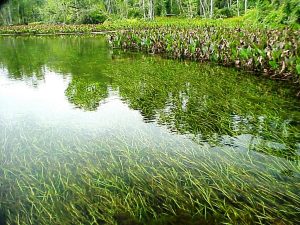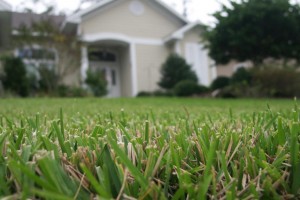Lawns are as American as apple pie, and Granny’s cookies. It’s where you play ball with your kids, and have summer cookouts. It’s also quite likely a huge source of frustration. How much water, how much fertilizer, how much work, and why bother? All of these are valid questions, and ones this article seeks to clarify. We’ll delve into the benefits of healthy lawns, and cover some easy cultural practices you can implement right now for a green and lush lawn all summer long.
The Benefits of Lawns
Turfgrass provides a number of ecological services. These are defined by the USDA as “direct and indirect benefits provided to humans by an ecosystem to include provisioning, regulating, supporting and cultural services”. This term has multiple categories, which are outlined below.
Provisioning (AKA Material and Energy Output)
Provisioning or material/energy output is linked to a grass’ bio-filtering capability. Grasses remove pollutants from applied water including stormwater, while enabling ground infiltration. This recharges surface reservoirs, and by removing pollutants, mitigates eutrophication while providing clean drinking water to communities.
Regulating (AKA Moderation and Control of Ecosystem Processes)
Grasses are known to cool the surrounding environment, capture dust, and prevent erosion.
Water absorbs heat as it vaporizes as it does in the evapotranspiration processes in plants. As Ben Franklin taught us many years ago, that process cools the environment around through heat absorption as water vaporizes. This cooling effect can be quite significant, and translates to saving through reduced air conditioning of your home.
Grasses remove dust and pollen particles from the air as well. This is usually a process by which wind blows the dust onto the grass, the dust settles and is captured beneath the grass canopy.
To complete the trifecta, grass has a thick root mass locking soil in place. The two main methods for soil erosion are through wind, and water flow. The grass’ root system negates both of these.
Supporting Services (AKA Maintaining Fundamental Ecosystem Processes)
Supporting services, as this sections title suggests, are those which support life processes. In the case of grasses, this comes in the form of organic matter. As I hear often, soils in Florida are quite sandy and lacking in the aforementioned organic matter.
It may surprise you to hear that grass is probably the easiest method to make these additions. As we leave clippings on the lawn and root systems slough off only to regrow the following spring we actually are adding organic matter from two directions. Hence grass’ reputation as a great soil builder.
This organic matter is where our supporting services really shine. Your turfgrass acts as habitat for microbiota, and macrobiota. These terms refer to the bacteria, fungi, algae, earthworms, and other insects which help cycle soil nutrients while breaking down the same organic matter you’ve added simply by not removing your grass clippings.
Cultural Services (AKA Societal Benefits)
These are somewhat self explanatory. It is in this realm where we begin to discuss those neighborhood block parties. Lawns are an excellent place to meet with neighbors and build communities. Well maintained lawns can also affect home prices, improve neighborhood aesthetics, and even effect crime rates in a given area.
It Starts with Cultural Practices
Hopefully by now, you are sold on keeping a healthy stress free lawn. The real question is how to achieve one? You’ve likely heard that lawns are difficult to maintain, but you’ll be happy to know it’s much easier than advertised. You’ll see rapid results if you start paying attention to three practices.
Irrigation
Easily the biggest killer of grasses in North Florida is irrigation. Often too much is applied, and is at the wrong time of day. All turfgrass species in Florida require only ½ -3/4 inch of water per irrigation event. Water your grass before dawn when you notice bent grass blades, slight color changes, and a lack of rebound when stepped upon.
Not sure how much you’re applying? Place some containers in your watering zone spread evenly and run the system for 15 minutes. Measure that outcome with a ruler, adjust your timing as necessary to hit the right amount.
Fertilization
Fertilization is based on turfgrass species. Overdoing things can be quite harmful to your lawn, so make sure you check the Florida Lawn Handbook for the specifics on your grass species.
Before you get started fertilizing, there are a few bits of information of which you should be aware. The first is your soil’s pH, as it dictates nutrient availability for your grass. The second factor in fertilization is timing. Apply fertilizer in multiple applications beginning April 15th and ending in September. This ensures your grass will have enough root mass to utilize the nutrients.
Mowing
Our final cultural practice is mowing. It is critical to mow plant to the appropriate height. Mowing to proper height keeps grass stress free reducing susceptibility to insects, disease, drought or sunscald. Here again, height is dependent on grass species. Consult the Florida Lawn Handbook for greater detail.
Whatever the height required. Make sure to mow grass with sharp blades, only when dry, and weekly to avoid damage to your plants.
To Sum it All Up
Turfgrasses are an integral part of any landscape when sited correctly. They provide a wealth of functions both ecological and cultural. Take a little time to integrate the practices outlined above and you’ll discover an easy to maintain groundcover primed for your next family cookout. As always, if you have any questions or need any help on this topic and more, contact your local Extension Office.
- Consider Chestnuts for Your Landscape - December 26, 2025
- Cold Protection for North Florida - November 6, 2025
- Planning and Planting for Wildlife - October 10, 2025


